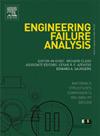基于动态同步换挡的手动变速器换挡臂断裂失效分析
IF 5.7
2区 工程技术
Q1 ENGINEERING, MECHANICAL
引用次数: 0
摘要
变速器换挡控制机构的可靠性对行车安全至关重要。针对8GS46B变速器商用车换挡臂断裂问题,通过动态换挡力及失效机理分析,找出断裂的根本原因,并提出工程解决方案,提高其可靠性。基于换挡同步性能,建立了换挡系统的受力模型;结合GSA (gear shift Analysis)试验确定了换挡臂所承受的动载荷,并将瞬态结构模拟与静态结构模拟进行了对比,结果表明瞬态结构模拟更符合实际工况。在540 N载荷作用下,换挡力的方向变化引起了应力状态的变化:未偏转时焊接中心处的最大应力为237 MPa,偏转10°后,焊接中心处的应力增加到258 MPa,弯曲处的应力达到222 MPa。根据强度设计准则和第四强度理论判断,这些应力值超过了Q235钢的屈服强度(235 MPa),这是导致断裂的根本原因。本研究提出了三种改进方案:方案一将宽度增加到42 mm,最大等效应力分别降低到171 MPa(挠曲前)和195 MPa(挠曲后);方案2用Q355钢代替Q235钢,最大等效应力分别为240 MPa和280 MPa(挠曲前和挠曲后);方案3采用局部优化(焊接端圆角,弯曲处加厚),最大等效应力分别降低为111 MPa(挠曲前)和123 MPa(挠曲后),与原结构相比分别降低53.1%和52.3%。三种方案的安全系数均达到1.2以上,满足强度要求;经综合评价,方案1不需修改工艺,兼顾经济效益,被确定为首选方案。该研究不仅解决了换挡臂断裂问题,而且其方法框架也为提高同类结构部件的可靠性提供了重要参考。本文章由计算机程序翻译,如有差异,请以英文原文为准。
Analysis of fracture failure of manual transmission gear shift arm based on dynamic synchronous shifting
The reliability of the gear shift control mechanism in transmissions is critical to driving safety. Aiming at the fracture issue of the gear shift arm in commercial vehicles equipped with the 8GS46B transmission, this study identified the root cause of the fracture and proposed engineering solutions to improve its reliability through the analysis of dynamic gear shift forces and failure mechanisms. A force model of the gear shift system was established based on gear shift synchronization performance; the dynamic loads borne by the gear shift arm were determined by integrating GSA (Gear Shift Analysis) tests, and the comparison between transient structural and static structural simulations revealed that transient structural simulation is more consistent with actual operating conditions. Under a load of 540 N, the directional change of the gear shift force caused a change in the stress state: the maximum stress at the welding center was 237 MPa without deflection, while after a 10° deflection, the stress at the welding center increased to 258 MPa and the stress at the bending position reached 222 MPa. Judged based on the strength design criteria and the fourth strength theory, these stress values exceeded the yield strength of Q235 steel (235 MPa), which is the fundamental cause of the fracture. This study proposed three improvement schemes: Scheme 1 involves increasing the width to 42 mm, which reduces the maximum equivalent stress to 171 MPa (before deflection) and 195 MPa (after deflection), respectively; Scheme 2 is replacing Q235 steel with Q355 steel, resulting in maximum equivalent stresses of 240 MPa and 280 MPa (before and after deflection, respectively); Scheme 3 adopts local optimization (fillet at the welding end and thickening at the bending position), which decreases the maximum equivalent stress to 111 MPa (before deflection) and 123 MPa (after deflection)—representing a reduction of 53.1 % and 52.3 % compared with the original structure. The safety factor of all three schemes reaches above 1.2, meeting the strength requirements; after a comprehensive evaluation, Scheme 1 is identified as the preferred scheme because it requires no process modification and balances economic efficiency. This study not only resolves the fracture problem of the gear shift arm, but its methodological framework also provides important reference for improving the reliability of similar structural components.
求助全文
通过发布文献求助,成功后即可免费获取论文全文。
去求助
来源期刊

Engineering Failure Analysis
工程技术-材料科学:表征与测试
CiteScore
7.70
自引率
20.00%
发文量
956
审稿时长
47 days
期刊介绍:
Engineering Failure Analysis publishes research papers describing the analysis of engineering failures and related studies.
Papers relating to the structure, properties and behaviour of engineering materials are encouraged, particularly those which also involve the detailed application of materials parameters to problems in engineering structures, components and design. In addition to the area of materials engineering, the interacting fields of mechanical, manufacturing, aeronautical, civil, chemical, corrosion and design engineering are considered relevant. Activity should be directed at analysing engineering failures and carrying out research to help reduce the incidences of failures and to extend the operating horizons of engineering materials.
Emphasis is placed on the mechanical properties of materials and their behaviour when influenced by structure, process and environment. Metallic, polymeric, ceramic and natural materials are all included and the application of these materials to real engineering situations should be emphasised. The use of a case-study based approach is also encouraged.
Engineering Failure Analysis provides essential reference material and critical feedback into the design process thereby contributing to the prevention of engineering failures in the future. All submissions will be subject to peer review from leading experts in the field.
 求助内容:
求助内容: 应助结果提醒方式:
应助结果提醒方式:


